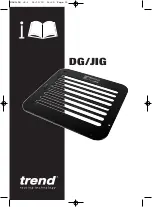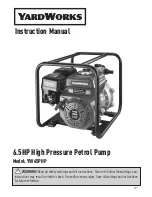
4
to be dislodged, fl y toward the operator side,
and possibly strike you or bystanders.
Match the appropriate bit and its speed
to your application. Do not use bits that
have a cutting diameter that exceeds the
capacity of the tool. Overloading the tool
can lead to personal injury or tool failure.
Position and securely clamp the router
bit in the collet before making any cuts.
If the bit becomes loose during operation,
it may fl y up and away from table possibly
striking you or bystanders.
Never use dull or damaged bits. Sharp
bits must be handled with care. Damaged
bits can snap during use. Dull bits require more
force to push the workpiece, possibly causing
the bit to break or material to kick back.
The router table is primarily designed to
cut fl at, straight and squared materials,
we do not recommend cutting material
that is warped, wobbly or otherwise
unstable. If the material is slightly
curved cut the material with the concave
side against the table or fence. Cutting
the material with the concave side up or
away from table may cause the warped or
wobbly material to roll; causing you to lose
control; kickback and serious personal injury
may result.
Never start the tool when the bit is
engaged in the material. The bit cutting
edge may grab the material causing loss of
control of the workpiece.
Feed the workpiece against the rotation of
the bit. The bit rotates counter-clockwise
as viewed from the top of table. Feeding
the work in the wrong direction will cause the
workpiece to “climb” up on the bit and may
lead to loss of control during operation.
Use push sticks and other jigs to hold
down the workpiece and keep your hands
away from the spinning blade. Router
cuts are blind cuts but the bit still protrudes
through the table and you must be aware
of the position of your hands relative to the
spinning bit.
Use of auxiliary in-feed and out-feed
supports is strongly suggested for long
or wide workpieces. Long workpieces can
fl ip offthe table or cause the table to tip over if
notfully supported.
Use the adjustable fence in straight
cutting applications. When routing along
an entireedge of the work, the fence and
adjustable support wedge will help maintain
stability.
Do not place material between router
bitand the fence while routing the edge.
This placement may cause the material to
become wedged, making kickback possible.
Never touch the bit during or immediately
after use. Contact with a spinning bit will
cause injury and after use the bit is too hot to
be touched by bare hands.
Do not use the table as workbench or
worksurface. The table is not intended to be
used as a workbench or work surface other
than for routing material. Using it for purposes
other than routing may cause damage and
make it unsafe to use in routing.
Never stand on the table or use as ladder
or scaffolding. Serious injury could occur
if the table is tipped or the cutting tool is
accidentally contacted. Do not store materials
on or near the table such that it is necessary to
stand on the table or its stand to reach them.
Use only Dremel replacement parts and
accessories. Any others may create a hazard.
Shaper/Router Table, Model 231
ATTACHMENT FOR USE WITH DREMEL ROTARY MODELS
100, 200, 300, 400XPR, 275, 285, 395, 398, 800, 4000, 8200
ATTENTION:
Read entire instruction
manual carefully before using your Dremel
Shaper/Router Table. Retain instructions for
future reference. This attachment will convert
Dremel Rotary Tools to a Shaper/Router
Table for edge forming, routing, grooving,
shaping, sanding edges, jointing, etc





































